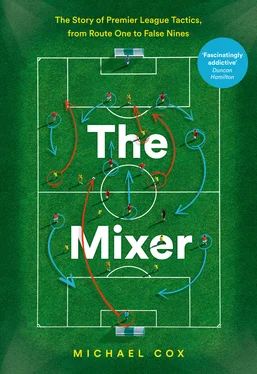Pearce, slightly surprisingly for a regular set-piece taker, looked particularly nervous when forced to play out and was responsible for the most famous misplaced back-pass of this era. After eight seconds of a November 1993 World Cup qualifier against minnows San Marino, he underhit the ball towards David Seaman, allowing Davide Gualtieri to give San Marino a shock 1–0 lead over England, who nevertheless won 7–1. That match was also the final England appearance for Pearce’s ex-Forest teammate Des Walker. He’d raced to 59 caps in the space of five years and was described as ‘the outfielder England manager Graham Taylor can least afford to lose’ in the Guardian a year earlier. But Walker discovered his talents no longer suited the modern game, and his England career was over at the age of 27. As Harry Redknapp later said, ‘When they did away with the back-pass in 1992 it made a huge dent in Des’s game. He used his speed to nip in front of the striker, mop up the ball and knock it back for the goalkeeper to pick up … suddenly, he was being required to play his way out of trouble, and that wasn’t his style at all.’
Indeed, one of the notable features of the early Premier League seasons – in line with Wilkinson’s prediction – was the frequent sight of defenders, when chasing long balls back towards their own goal, simply hacking the ball out of play to concede a throw-in. ‘I’ve told the players, “If you’re in doubt, kick it out,”’ said Coventry manager Bobby Gould. ‘“Stop fannying about and put it in Row Z.”’ It’s no coincidence that the first PFA Player of the Year during the Premier League era was Paul McGrath, the Aston Villa centre-back who played the ball comfortably with both feet. No other defender adjusted so impressively to the new law, and the Irishman became the template for the modern centre-back, as managers increasingly required ball-playing defenders rather than old-fashioned cloggers. A player like Rio Ferdinand, for example, would have been a midfielder rather than a centre-back were it not for the back-pass change.
Inevitably, the role of goalkeepers changed enormously. It was the first time that they had been forced to adjust since the 1912 law change that ruled they could handle only inside the penalty box rather than in the entirety of their own half. Goalkeepers, rightly famous for moaning, were outraged. ‘The new rule is making a mockery of my profession,’ complained Alan Hodgkinson, the ex-England shotstopper who became renowned as the country’s first specialist goalkeeping coach. ‘I know people will assume I’m biased but I can’t see the value of setting up goalkeepers so they look foolish. There’s not one who hasn’t been caught out. Is that good for the game? You have to remember that keepers have spent 20 years learning to catch the ball. It’s second nature to them. It’s not easy to adjust.’ Tough luck. The rules were here to stay, and goalkeepers were forced to spend long training sessions practising an entirely new skill – kicking a moving ball. The goalkeeper, football’s most specialised position, needed to become more of an all-rounder.
One of Hodgkinson’s key achievements was recommending Peter Schmeichel to Manchester United manager Alex Ferguson, before acting as the Dane’s coach. Schmeichel would define goalkeeping during this period, and was the only Premier League player who was the world’s greatest in his position. He was physically imposing, capable of tremendous close-range reaction stops and a master of the double save, springing up quickly to thwart rebounds. Schmeichel’s approach wasn’t textbook, and his positioning wasn’t as flawless as Arsenal’s Seaman, his goalkeeping rival of the 1990s. The Arsenal shotstopper was his opposite: quiet, understated and solid, whereas Schmeichel was loud, bold and unpredictable. Schmeichel introduced English football to the ‘starjump’ save – where he would spread arms and legs while leaping towards a striker – having borrowed it from handball, which Schmeichel played regularly as a teenager. ‘A goalkeeper is not a footballer, a goalkeeper is a handball player,’ former Manchester City manager Malcolm Allison declared in the 1960s. For Schmeichel, that was literally true.
Schmeichel had benefited heavily from the pre-back-pass situation. He started the Premier League era on a completely unexpected high, having won Euro 92 with Denmark – who hadn’t even qualified for the tournament initially, but were handed a late reprieve when civil war forced Yugoslavia to withdraw. In the last major tournament before the back-pass change, Denmark demonstrated why reform was desperately required, with centre-back Lars Olsen continually knocking balls back to Schmeichel to pick up, an approach that gradually spread to the rest of the side. The second half of the final, a 2–0 victory over Germany, featured particularly infuriating examples of time wasting. With five minutes remaining, Danish forward Flemming Povlsen collected the ball midway inside his own half, dribbled determinedly towards the opposition goal, but was tripped on the halfway line. He picked himself up, dusted himself down, then turned around and fired the ball 50 yards back to Schmeichel. ‘Every time we got into the German half and couldn’t find someone to pass to, players would turn around and pass to me, and I would pick it up,’ Schmeichel later recalled somewhat sheepishly. ‘How can you win football matches like that?!’
The new law forced goalkeepers to become more comfortable in possession, and Schmeichel was proactive in evolving. Upon arriving at Manchester United the previous summer, with back-pass reform on the horizon, Schmeichel insisted that the goalkeepers should play a more active role in training. Rather than being separated from the main group, Schmeichel wanted to take part in passing sessions with the outfielders, an important change both tactically and psychologically. He would later stun opponents by charging upfield for corners when United were behind in the dying seconds, sometimes with great success. This has become accepted practice in modern times, but Schmeichel introduced the concept to English supporters, first showcasing his attacking qualities on Boxing Day 1994, when United were 1–0 down at home to Blackburn Rovers. With three minutes remaining, Schmeichel raced forward into the opposition box, distracting three startled opponents and enabling Gary Pallister to find space; he headed towards goal, and Paul Ince smashed in the equaliser.
Schmeichel had already scored multiple times in Denmark, and later netted a consolation goal for United with a powerful header in a 1995 UEFA Cup tie against Russian side Rotor Volgograd. He also had an overhead kick against Wimbledon disallowed for offside – surely the first-ever goalkeeper penalised for that offence – and would, fittingly, become the first Premier League goalkeeper to score, during his sole season at Aston Villa. Schmeichel was a genuine revolutionary, convincing fellow goalkeepers that they weren’t simply about defending their own goal from opposition attacks and that they could launch – and indeed finish – attacks of their own.
But Schmeichel wasn’t particularly reliable with his feet in traditional goalkeeping areas. In Manchester United’s second-ever Premier League game, a 3–0 home defeat to Everton, the great Dane made the first possession-based goalkeeping error of the post-back-pass era when he was tackled by Everton’s Mo Johnston, who curled the ball home. The majority of Schmeichel’s errors came with his feet or when sweeping outside his penalty box; he kicked the ball straight to West Ham’s Matthew Holmes in February 1994, allowing the winger to cross for a Trevor Morley goal, then three months later gifted Ipswich’s Chris Kiwomya an open goal when air-kicking outside his box, and he was dismissed in an FA Cup quarter-final against Charlton when handling 15 yards outside his penalty area.
Читать дальше












